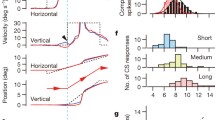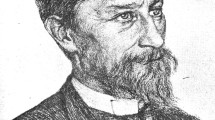Summary
In precollicular decerebrate cats, limb nerves have been stimulated and field potentials and unitary activity recorded from the cerebellar cortex. Doses of pentothal up to 8 mg/kg affect neither the activity evoked in the fast mossy fibre pathways, nor the size of the postsynaptic potentials in granule cells, but the axon discharge in these latter cells is clearly affected. With 4–8 mg/kg the axon discharge of granule cells is abolished and as a consequence Purkinje cells do not respond to the peripheral stimulation via the mossy fibres. In contrast the activity evoked through the climbing fibres is enhanced. This effect takes place at precerebellar level. Both the effects on the mossy fibre and climbing fibre pathways show a recovery in 15–60 min depending on the dose.
Similar content being viewed by others
References
Bisti, S., Iosif, G., Marchesi, G.F., Strata, P.: Pharmacological properties of inhibitions in the cerebellar cortex. Exp. Brain Res. 14, 24–37 (1971).
Bloedel, J.R., Roberts, W.J.: Functional relationship among neurons of the cerebellar cortex in the absence of anesthesia. J. Neurophysiol. 32, 75–84 (1969).
Buchtel, H.A., Iosif, G., Marchesi, G.F., Provini, L., Strata, P.: Analysis of the activity evoked in the cerebellar cortex by stimulation of the visual pathways. Exp. Brain Res. 15, 278–288 (1972).
Dow, R.S., Moruzzi, G.: The Physiology and Pathology of the Cerebellum, pp. 675. Minneapolis: The University of Minnesota Press 1958.
Eccles, J.C., Faber, D.S., Murphy, J.T., Sabah, N.H., Táboříková, H.: Afferent volleys in limb nerves influencing impulse discharges in cerebellar vortex. I. In mossy fibers and granule cells. Exp. Brain Res. 13, 15–35 (1971a).
—: Investigations on integration of mossy fiber inputs to Purkyně cells in the anterior lobe. Exp. Brain Res. 13, 54–77 (1971b).
—, Faber, D.S., Táboříková, H.: The action of a parallel fiber volley on the antidromic invasion of Purkinje cells of cat cerebellum. Brain Res. 25, 335–356 (1971).
—, Ito, M., Szentágothai, J.: The cerebellum as a neuronal machine, pp. 335. Berlin-Heidelberg-New York: Springer 1967.
—, Provini, L., Strata, P., Táboříková, H.: Analysis of electrical potentials evoked in the cerebellar anterior lobe by stimulation of hindlimb and forelimb nerves. Exp. Brain Res. 6, 171–194 (1968a).
—: Topographical investigation on the climbing fiber inputs from forelimb and hindlimb afferents to the cerebellar anterior lobe. Exp. Brain Res. 6, 195–215 (1968b).
—, Sasaki, K., Strata, P.: Interpretation of the potential fields generated in the cerebellar cortex by a mossy fibre volley. Exp. Brain Res. 3, 58–80 (1967).
Gordon, M., Rubia, F.J., Strata, P.: Sensitivity to pentothal of a synapse in the cerebellar cortex. Arch. Fisiol. 68, 330 (1972a).
—: The effect of barbiturate anaesthesia on the transmission to the cerebellar cortex. Brain Res. 43, 677–680 (1972b).
Körlin, D., Larson, B.: Differences in cerebellar potentials evoked by the group I and cutaneous components of the cuneocerebellar tract. In: “Excitatory synaptic mechanisms”. Ed. by Andersen, P., Jansen, J.K. S. Oslo-Bergen-Tromsö: Universitetsforlaget 1970.
Latham, A., Paul, D.H.: Effects of sodium thiopentone on cerebellar neurone activity. Brain Res. 25, 212–215 (1971).
Løyning, Y., Oshima, T., Yokota, T.: Site of action of thiamylal sodium on the monosynaptic spinal reflex pathway in cats. J. Neurophysiol. 27, 408–428 (1964).
Maekawa, K., Simpson, J.I.: Climbing fiber activation of Purkinje cells in the flocculus by impulses transferred through the visual pathway. Brain Res. 39, 245–251 (1972).
Murphy, J.T., Sabah, N.H.: Spontaneous firing of cerebellar Purkinje cells in decerebrate and barbiturate anesthetized oats. Brain Res. 17, 515–519 (1970).
Oscarsson, O: The sagittal organization of the cerebellar anterior lobe as revealed by the projection patterns of the climbing fiber system. In: “Neurobiology of cerebellar evolution and development”, pp. 525–537. Ed. by R. Llinás. Chicago: American Medical Association, Education and Research Foundation 1969.
Rossi, G.F., Zanchetti, A.: The brain stem reticular formation. Anatomy and Physiology. Arch. ital. Biol. 95, 203–435 (1957).
Sasaki, K., Strata, P.: Responses evoked in the cerebellar cortex by stimulating mossy fibre pathways to the cerebellum. Exp. Brain Res. 3, 95–110 (1967).
Thach, W.T.: Somatosensory receptive fields of single units in cat cerebellar cortex. J. Neurophysiol. 30, 675–696 (1967).
Author information
Authors and Affiliations
Additional information
Postgraduate student of the Scuola Normale Superiore of Pisa.
Supported by the Deutsche Forschungsgemeinschaft.
Rights and permissions
About this article
Cite this article
Gordon, M., Rubia, F.J. & Strata, P. The effect of pentothal on the activity evoked in the cerebellar cortex. Exp Brain Res 17, 50–62 (1973). https://doi.org/10.1007/BF00234563
Received:
Issue Date:
DOI: https://doi.org/10.1007/BF00234563




